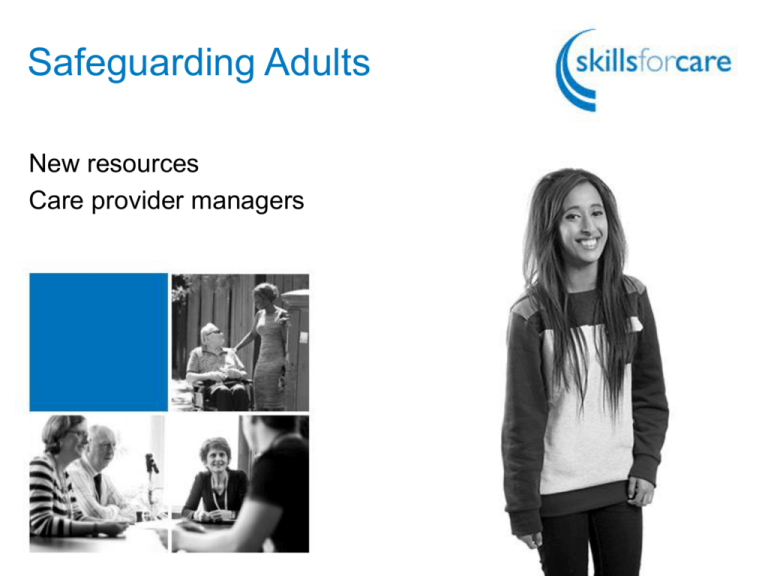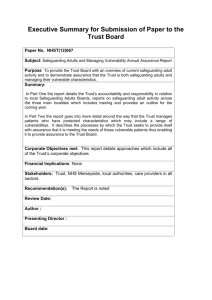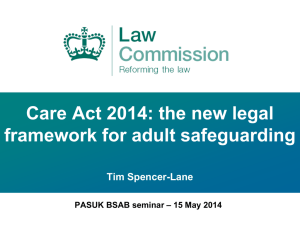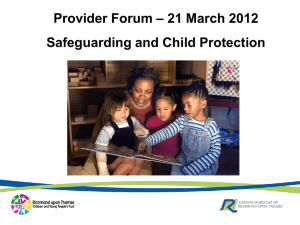SfC-Safeguarding-event-22.10.15-for-attendees
advertisement

Safeguarding Adults New resources Care provider managers 9.30 Registration 10.00 Introductions and Housekeeping 10.05 Expectations of Provider managers – Jim Thomas Programme Head Skills for Care Preventing abuse Responding to concerns 10.15 Care Act changes to Safeguarding – revision of Pan London Safeguarding Adults Procedures Mary Wynne – Safeguarding Adults Co-ordinator, RB Kensington and Chelsea 10.30 Questions 10.40 Table discussions with Safeguarding leads and commissioners What are the provider manager’s challenges in meeting Safeguarding expectations? How can they work with commissioners and safeguarding leads to meet expectations? 11.15 Break and networking 11. 40 Resources to help you meet CQC fundamental standards for a Safe service • Table exercise identifying evidence opportunities for PIR completion and inspections 12.30 New Resources 12.40 Table discussion How are you going to use the information and resources you have heard about today? Feedback 12.50 Final Questions 1 pm Lunch and networking Jim Thomas Programme Head Workforce Innovation CQC State of Care Report First report since new inspection approach started • Safety is one of five key lines of enquiry • Services are rated on each of the five areas and also given an overall rating. • Services were generally performing well in the other four areas • The report cited safety as the greatest concern in the sector, with a third of adult care services also rated ‘requires improvement’ in this area. • State of Care report launched today | Care Quality Commission Safeguarding Adults and The Care Act 2014 Mary Wynne Chair- London Safeguarding Adults Network Three Boroughs Professional Standards and Safeguarding Team (RBKC, WCC,LBHF) Oct 2015 What does the Care Act do? The Act is built around people, it: ensures that people’s well-being, and the outcomes which matter to them, will be at the heart of every decision that is made; puts carers on the same footing as those they care for; creates a new focus on preventing and delaying needs for care and support, rather than only intervening at crisis point, and building on the strengths in the community; embeds rights to choice ensuring a range of high quality services are available locally. Care Act 2014-guidance There is not a lot of detail in the Act. Much of this is in the content of the Regulations and Statutory Guidance (Safeguarding Chapter 14). Practice Guidance is now available from SCIE Practice Guidance Info Sharing Guide Powers of Entry Guidance SAB checklist SAR’s implementation support The statutory guidance: chapter by chapter Ch Topic Ch Topic 1 Promoting wellbeing 12 Direct payments 2 Preventing, reducing or delaying needs 13 Review of care and support plans 3 Information and advice 14 Safeguarding 4 Market shaping and commissioning 15 Integration, cooperation and partnerships 5 Managing provider failure 16 Transition to adult care and support 6 Assessment and eligibility 17 Prisons and approved premises 7 Independent advocacy 18 Delegation of local authority functions 8 Charging and financial assessment 19 Ordinary residence 9 Deferred payment agreements 20 Continuity of care 10 Care and support planning 21 Cross-border placements 11 Personal budgets 22 Sight registers 23 Transition to the new legal framework Areas with related regulations The Care Act: reforming care and support Safeguarding and the Care Act Summary • Make Safeguarding Adults Boards (SAB) statutory • Make safeguarding enquiries a corporate duty for councils • Make serious case reviews mandatory when certain triggering situations have occurred and the parties believe that safeguarding failures have had a part to play • Place duties to co-operate over the supply of information on relevant agencies • Place a duty on councils to fund advocacy for assessment and safeguarding for people who do not have anyone else to speak up for them Six key principles underpin adult safeguarding work Empowerment Prevention Proportionality Protection Partnership Accountability Promoting well-being Section 1 Local authorities will have a general duty, when undertaking adult social care functions with an individual, to promote their well-being. This includes “protection from abuse and neglect”. Section 1: Duty to promote individual well-being 1. physical and mental health, emotional well-being and personal dignity 2. protection from abuse and neglect 3. control by the individual over day-to-day life (including over care and support, or support, provided to the individual and the way in which it is provided) 4. participation in work, education, training or recreation 5. social and economic well-being 6. domestic, family and personal relationships 7. Suitability of living accommodation 8. the individual’s contribution to society Section 1: must have regard to... Assumption that the person is the best judge of their well-being Minimum restrictions The person’s views, wishes and feelings Individual wellbeing Protect from abuse and neglect Balance with well-being of carers Have regard to all the adult’s circumstances Full participation in decision making Duty to assess needs for care and support Sections 9 and 11 A local authority must assess a person’s needs for care and support unless that person refuses an assessment. But an assessment cannot be refused, and the local authority must carry it out, if the person lacks capacity to refuse and carrying it out would be in their best interest, or the adult is experiencing, or is at risk of, abuse or neglect. Care Act- shifts in language ‘Safeguarding investigations’ become ‘safeguarding enquiries’ ‘Safeguarding concerns’ ‘Serious alerts’ are ‘safeguarding Case Reviews’ become ‘Safeguarding Adult Reviews’ Categories of Abuse Physical abuse – including assault, hitting, slapping, pushing, misuse of medication, restraint or inappropriate physical sanctions. Sexual abuse – including rape, indecent exposure, sexual harassment, inappropriate looking or touching, sexual teasing or innuendo, sexual photography, subjection to pornography or witnessing sexual acts, indecent exposure and sexual assault or sexual acts to which the adult has not consented or was pressured into consenting. Psychological abuse – including emotional abuse, threats of harm or abandonment, deprivation of contact, humiliation, blaming, controlling, intimidation, coercion, harassment, verbal abuse, cyber bullying, isolation or unreasonable and unjustified withdrawal of services or supportive networks. Financial or material abuse – including theft, fraud, internet scamming, coercion in relation to an adult’s financial affairs or arrangements, including in connection with wills, property, inheritance or financial transactions, or the misuse or misappropriation of property, possessions or benefits Categories of Abuse Discriminatory abuse – including forms of harassment, slurs or similar treatment; because of race, gender and gender identity, age, disability, sexual orientation or religion. Organisational abuse – including neglect and poor care practice within an institution or specific care setting such as a hospital or care home, for example, or in relation to care provided in one’s own home. Neglect and acts of omission – including ignoring medical, emotional or physical care needs, failure to provide access to appropriate health, care and support or educational services, the withholding of the necessities of life, such as medication, adequate nutrition and heating 3 new categories of abuse Domestic violence – including psychological, physical, sexual, financial, emotional abuse; so called ‘honour’ based violence. Modern slavery – encompasses slavery, human trafficking, forced labour and domestic servitude. Self-neglect – this covers a wide range of behaviour neglecting to care for one’s personal hygiene, health or surroundings and includes behaviour such as hoarding. Safeguarding adults enquiry Section 42 The local authority must make (or cause to be made) whatever enquiries it thinks necessary to enable it to decide whether any action should be taken and, if so, what and by whom where it has reasonable cause to suspect that an adult in its area (whether or not ordinarily resident there) has : needs for care and support (whether or not the local authority or anybody else is meeting those needs) is experiencing, or is at risk of, abuse or neglect, and as a result of those needs is unable to protect himself or herself against the abuse or neglect or the risk of it Thresholds There is a low test for triggering a safeguarding enquiry: Claire Crawley, policy lead for safeguarding adults at the DH described this recently as ‘the Care Act has no eligibility criteria for safeguarding (other than the key 3 factors of care & support needs / risk / unable to safeguard themselves)’. The Act is clear that concerns relate to abuse, neglect, or the risk of either of these. There is no test for ‘harm’ or ‘significant harm’ This may either Resolve the debates locally and nationally about thresholds Shift those debates from ‘what is the threshold for a safeguarding investigation’ to ‘what safeguarding enquiry is appropriate to this particular concern’. Statutory Guidance Para 14.37. An enquiry could range from a conversation with the individual who is the subject of the concern to a much more formal multi-agency arrangement. The purpose of the enquiry is to decide whether or not the LA or another organisation, or person, should do something to protect them from any actual or risk of abuse or neglect. Who can carry out an enquiry? Although the LA is the lead agency for making enquiries, it may require others to undertake them (cause enquiries to be made). The local authority retains the responsibility for ensuring that the enquiry is referred to the right place and is acted upon. The specific circumstances will often determine who is the right person to begin an enquiry e.g. GP, Fire Officer, social worker, a housing support worker other health worker such as a community nurse. Police if its a crime The local authority, in its lead and coordinating role, should assure itself that the enquiry satisfies its duty under section 42 In this role if the local authority has asked someone else to make enquiries, it is able to challenge the body making the enquiry if it considers that the process and/or outcome is unsatisfactory. Care Act Statutory Guidance Highlights for Providers LGA, ADASS DH Guide Aug 2015 Highlights Supporting Staff Staff are clear about their responsibilities, know where to go locally for help/advice and must have access to practical and legal guidance There should be effective and well publicised ways of escalating concerns where immediate line managers do not take action in a response to a concern being raised. Agencies should support development of positive learning environment Regular face to face supervision from skilled managers is essential to enable staff to work confidently and competently in difficult and sensitive situations Employers must ensure staff keep accurate records Staff should be made aware of their rights under employment law and any disciplinary procedures Highlights Policies and Procedures In any organisation there should be adult safeguarding policies and procedures which should reflect the statutory guidance. Such policies should assist those working with adults to develop swift and personalised safeguarding responses and how to involve adults in the decision making. Therefore be aware of the need for adult safeguarding policies and procedures and the areas to cover; benchmark against existing policies and procedures and draw up new ones where required. Decision Making Tree Highlights Culture- taking the ‘adversarial’ out of safeguarding Break down cultures that seek to scapegoat or blame practitioners Commissioners of care or other professionals should only use safeguarding procedures in a way that reflects the 6 safeguarding principles not as a means of intimidating providers or families Transparency, open- mindedness and timeliness are important features of fair and effective safeguarding enquiries Commissioners should encourage an open culture working in partnership with providers to ensure the best outcomes for the adult Highlights Quality versus Safeguarding? Need to clarify how responses to safeguarding concerns deriving from poor quality and inadequacy of service provision including patient safety should be responded to. Repeated instances of poor care may be an indication of more serious problems and of what we now describe as organisational abuse. Important that information is recorded and shared and emerging patterns identified. Agencies should implement robust risk management processes in order to prevent concerns escalating to a crisis point and requiring intervention under safeguarding procedures CQC and commissioners have alternative means of raising standards including support for staff training, contract compliance and enforcement powers. Highlights Information Sharing Early information sharing is the key to providing effective responses where there are emerging concerns All orgs must have arrangements in place which set out clearly the processes and principles for info sharing If a professional has concerns then they should share the information with the LA and or the police if they suspect a crime has been committed. When an employer is aware of abuse or neglect in their org they are under a duty to correct this and protect the adult from harm ASAP and inform the LA, CQC and CCG where the latter is the commissioner. If someone knows that abuse or neglect is happening they must act upon this knowledge not wait to be asked for information. Highlights Making Enquiries The employers should investigate any concern unless there is compelling reason why it is inappropriate or unsafe to do this e.g. conflict of interest, performance of the provider in undertaking past investigations or serious multiple concerns or a matter requiring a police investigation. If the LA decides that another org should make the enquiry then the LA should be clear about timescales, the need to know the outcomes and what action will follow if this is not done. The LA should assure itself that the enquiry satisfies its duty under s42..In this role if the LA has caused an enquiry to be made it is able to challenge the agency if it considers the process or outcome unsatisfactory. Where a crime is suspected....then the police must lead the criminal investigation. Highlights HR Processes Employers should ensure that their disciplinary procedures are compatible with the responsibility to protect adults at risk of abuse or neglect. When criminal procedures are concluded without action being taken this does not automatically mean that regulatory or disciplinary procedures should cease or not be considered. Highlights Criminal Investigations The Police and Crown Prosecution Service (CPS) should agree procedures with the LA, care providers, housing providers, and the NHS/CCG to cover the following situations: action pending the outcome of the police and the employer’s investigations; action following a decision to prosecute an individual; action following a decision not to prosecute; action pending trial; and responses to both acquittal and conviction. Highlights Cooperating Sections 6 and 7 Section 6 creates a general duty to cooperate and section 7 a specific duty on individual cases when requested by a LA. Section 6- LA’s must cooperate with each of their relevant partners and those partners must cooperate with the LA e.g. NHSE, CCG’s, NHS Trusts, DWP, Police, Probation and Prisons Section 7-LA’s must also cooperate with such other agencies as it considers appropriate e.g. GP’s, dentists, pharmacists, housing, health and care providers The request must be complied with unless it is “incompatible with its own duties” or “would otherwise have an adverse effect on the exercise of its functions”. Written reasons must be given for a decision not to comply with a request. Highlights Mental Capacity Act 2005/Making Safeguarding Personal Professionals and staff need to understand and always work in line with the MCA 2005. They will need considerable guidance and support from their employers if they are to help adults manage risk in ways that put them in control of decision making Making Safeguarding Personal 2014 Making Safeguarding Personal Making Safeguarding Personal is a shift in culture and practice. It is about having conversations with people about how we might respond in safeguarding situations in a way that enhances involvement, choice and control as well as improving quality of life, wellbeing and safety. It is about seeing people as experts in their own lives and working alongside them. Undue Influence? If the adult has the capacity to make decisions in this area of their life and declines assistance, this can limit the intervention that organisations can make. The focus should therefore be, on harm reduction. It should not however limit the action that may be required to protect others who are at risk of harm. The potential for ‘undue influence’ will need to be considered if relevant. If the adult is thought to be refusing intervention on the grounds of duress then action must be taken. In order to make sound decisions, the adult’s emotional, physical, intellectual and mental capacity in relation to self-determination and consent and any intimidation, misuse of authority or undue influence will have to be assessed SAB-supply of information Section 45 A SAB may request a person to supply information to it or to another person. The person who receives the request must provide the information provided if: •the request is made in order to enable or assist the SAB to do its job; •the request is made of a person who is likely to have relevant information SARs Section 44 The purpose of Safeguarding Adults Reviews (Serious Case Reviews) is to identify the lessons to be learnt from a case, and applying those lessons to future cases. SABs may arrange for a review for any case, but must arrange them where there is reasonable cause for concern about how the SAB, members of it or other persons with relevant functions worked together to safeguard the adult and either • the adult has died, and the SAB knows or suspects that the death resulted from abuse or neglect, or • the adult is still alive, and the SAB knows or suspects that the adult has experienced serious abuse or neglect The DASM- changes expected Statutory guidance states that each statutory member of the SAB should have a Designated Adult Safeguarding Manager (DASM). That is: the local authority, the CCG and the police. The DASM is responsible for the management and oversight of individual complex cases and coordination where allegations are made or concerns raised about a person, whether an employee, volunteer or student, paid or unpaid. The DASMs to work with care and support providers and other service providers e.g. housing and NHS trusts to ensure that referral of individual employees to the DBS and, or, Regulatory Bodies (e.g. CQC, HCPC, GMC, NMC) are made promptly and appropriately and that any supporting evidence required is made available. The revised statutory guidance expected soon will have changes on the role of the DASM Statutory duty of candour for health and adult social care providers New Care Quality Commission registration requirements introduces a duty of candour under the Health & Social Care Act 2008 (Regulated Activities) Regulations 2014. Since Nov 2014, NHS providers are required to comply with the duty of candour. Meaning they must be open and transparent with service users about their care and treatment, including when it goes wrong. The duty was introduced as part of the fundamental standard requirements for all providers. It applies to all NHS trusts, foundation trusts and special health authorities From April 2015 it now applies to all other providers. New offences of ill-treatment or wilful neglect In Nov 2013, the Govt accepted the recommendation of the National Advisory Group on the Safety of Patients in England that a new statutory criminal offence of illtreatment or wilful neglect should be created. The Criminal Justice and Courts Act 2015 establishes 2 offences which came into effect from 13 April 2015 Section 20: Ill-treatment or wilful neglect: care worker offence Section 21: Ill-treatment or wilful neglect: care provider offence Table discussion Introducing - Safeguarding Leads Jenny Moran - Bromley Denise Roach -RBKC Andrew Hill – Kingston Jackie Bennett – Hillingdon Rachel Adelson-Kettle – Islington Seamus Doherty – Harrow Sophie Shah – Ealing Nicole Booty - Havering Table discussion Introducing Commissioners Sue Newton – Islington Helen Shewa – Southwark Andy Loxton - Southwark Carole Ferguson – Camden Jason McCulloch – Greenwich Barbara Disney – Tower Hamlets Table discussion Meeting Care Act expectations • What are the provider manager’s challenges in meeting Safeguarding expectations? Write on Post it notes • How can you work with commissioners and safeguarding leads to meet expectations? • Group Post -it notes on flip chart paper • Record suggested ways to work together on flip chart paper Care Quality Commission - Is the service Safe? CQC – Is the service Safe? The new approach CQC seminar – Is the service Safe? Provider Handbook & Appendices CQC seminar 5 Key Questions: CQC – Is the service Safe? BY SAFE WE MEAN THAT PEOPLE ARE PROTECTED FROM ABUSE AND AVOIDABLE HARM How are people protected from bullying, harassment, avoidable harm and abuse that may breach their human rights? How are risks to individuals and the service managed so that people are protected and their freedom is supported and respected? How does the service make sure that there are sufficient numbers of suitable staff to keep people safe and meet their needs? How are people’s medicines managed so that they receive them safely? How well are people protected by the prevention and control of infection? (not mandatory) Table exercise Meeting CQC “Safe” standard Identifying evidence opportunities for PIR completion and inspections Have a go at filling it in! CQC – Is the service Safe? Care Improvement works http://www.careimprovementworks.org.uk CQC – Is the service Safe? Rachel Reid rachel.reid@skillsforcare.org.uk 07770507812 Website : www.skillsforcare.org.uk New Resources Jim Thomas • A guide to adult safeguarding for social care service providers • Safeguarding Route Planner Table discussion How will you use what you have heard about today? Feedback on how you can use the information and resources we have talked about today Write on Post-its and put on flip chart Registered Managers Registered Managers networks If you are interested in joining a network or would like to start one! Contact your Skills for Care Locality Manager Locality Managers London North West – Donna.Bunce@skillsforcare.org.uk North Central – Voyta.Camek@skillsforcare.org.uk North East – Ali.Rusbridge@skillsforcare.org.uk South East – Linda.MacEachen@skillsforcare.org.uk South West – Laura.Anthony@skillsforcare.org.uk Thank you









